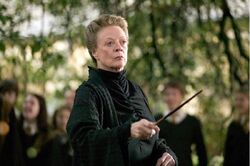Ironyak1-bot (talk | contribs) m (Add spoiler alert) |
Tag: Visual edit |
||
| Line 25: | Line 25: | ||
===Length and Flexibility=== |
===Length and Flexibility=== |
||
| − | Nine-inch wands are very uncommon, and, according to Garrick Ollivander, wands favour more elegant and refined spell-casting. Since wand rigidity is a detonator as to how willing a wand is to change allegiance, it can be said that McGonagall's wand was not easily persuaded to change causes.<ref>https://www.pottermore.com/writing-by-jk-rowling/wand-lengths-and-flexibilit</ref> |
+ | Nine-inch wands are very uncommon, and, according to Garrick Ollivander, neater wands favour more elegant and refined spell-casting. Since wand rigidity is a detonator as to how willing a wand is to change allegiance, it can be said that McGonagall's wand was not easily persuaded to change causes.<ref>https://www.pottermore.com/writing-by-jk-rowling/wand-lengths-and-flexibilit</ref> |
==History== |
==History== |
||
Revision as of 00:41, 10 November 2020

|
Warning!
At least some content in this article is derived from information featured in Harry Potter: Hogwarts Mystery. Spoilers will be present within the article. |
- "My august grandfather, Gerbold Octavius Ollivander, always called wands of this wood ‘the survivor’s wand'."
- — Garrick Ollivander[src]
Minerva McGonagall's wand was 9½ inches long, made of fir wood, and had a dragon heartstring core.The wand was very well suited to Transfiguration, proven by its owner, who was a Professor of the subject and an Animagus. This wand was manufactured by Garrick Ollivander. The wand was very much like it's owner: elegant, refined and very powerful.
Wandlore
Wood
Fir wands are stated to align to wizards and witches who are particularly suited to Transfiguration, and who have a tendency to survive "mortal peril". McGonagall was Transfiguration Professor at Hogwarts School of Witchcraft and Wizardry, and, in 1996, survived four simultaneous Stunning Spells taken to the chest with only a brief stint in St Mungo's Hospital for Magical Maladies and Injuries despite her age at the time. She also survived the whole of the Second Wizarding War, including the Battle of Hogwarts, despite being a prime target due to her close association with Albus Dumbledore.
Core
As a rule, dragon heartstrings produce wands with the most magical power, capable of the most flamboyant spells. Dragon heartstring wands tend to learn quicker than other types. While they can change allegiance if won from their original master, they always bond strongly with the current owner. The dragon heartstring wand tends to be easiest to turn to the Dark Arts, though it will not incline that way of its own accord. It is also the most prone of the three cores to accidents, being somewhat temperamental.[1]
Length and Flexibility
Nine-inch wands are very uncommon, and, according to Garrick Ollivander, neater wands favour more elegant and refined spell-casting. Since wand rigidity is a detonator as to how willing a wand is to change allegiance, it can be said that McGonagall's wand was not easily persuaded to change causes.[2]
History

McGonagall with her wand drawn
This wand was purchased at Ollivanders by Minerva before she began her education at Hogwarts School of Witchcraft and Wizardry. This wand later proved itself useful for Transfiguration, when she became an Animagus and eventually went on to teach the subject of Transfiguration. It could also perform other spells such as the Imperius Curse with little effort.
It can be assumed she wielded this wand throughout the First Wizarding War, while being a member of the Order of the Phoenix.
After the death of her dear friend and colleague, Albus Dumbledore, Minerva drew her wand from her sleeve and raised it into the air as both a sign of respect and a means of ridding the sky above of the Dark Mark, quickly followed by the rest of the attendees.
Minerva also used it against several Death Eaters prior to the Battle of Hogwarts, casting the Imperius Curse on Amycus Carrow and expelling Severus Snape from the castle with a number of powerful offensive spells. It was also used to reinforce the castle's magical protections and to animate the various statues and suits of armour in Hogwarts casting the charm Piertotum Locomotor, which Minerva had been very eager to use for a very long time.
McGonagall has been able to perform very powerful and advanced magic with this wand, such as in the Battle of Hogwarts, when she was able to conjure three Patronuses and while duelling numerous Death Eaters throughout the first and second stages of the battle. Along with the wands of Kingsley Shacklebolt and Horace Slughorn, Minerva's wand battled with the unbeatable Elder Wand in the hand of Lord Voldemort and survived unscathed.
She most likely continued to use this wand after the final battle, during her time as Headmistress of Hogwarts and into her retirement as well.
Behind the scenes
- In the film adaptations, the wand is sixteen and a half inches with a glass piece protruding out of the elaborate handle.
- The glass tip on the wand was highly breakable and in order not to snap it off, Dame Maggie Smith used long, sweeping gestures.
- In the film adaptations the wand is one of the few that has had a consistent design throughout all the films in the series. However, some websites show the wand did not have a sphere-like handle with a smooth rod in the first two films.
- If one is to look closely at the glass cabinet on Garrick Ollivander's counter in the film adaptation of Harry Potter and the Philosopher's Stone, a wand that looks exactly like Minerva McGonagall's wand is visible. This suggests that even in the first two films the wands were made of resin.
Appearances

Minerva McGonagall, her wand drawn, during the Battle of Hogwarts in 1998
- Harry Potter and the Philosopher's Stone (First appearance)
- Harry Potter and the Chamber of Secrets
- Harry Potter and the Chamber of Secrets (film)
- Harry Potter and the Prisoner of Azkaban
- Harry Potter and the Goblet of Fire
- Harry Potter and the Goblet of Fire (film)
- Harry Potter and the Order of the Phoenix
- Harry Potter and the Order of the Phoenix (film)
- Harry Potter and the Order of the Phoenix (video game)
- Harry Potter and the Half-Blood Prince
- Harry Potter and the Half-Blood Prince (film)
- Harry Potter and the Deathly Hallows
- Harry Potter and the Deathly Hallows: Part 2
- Harry Potter and the Deathly Hallows: Part 2 (video game)
- LEGO Harry Potter: Years 1-4
- LEGO Harry Potter: Years 5-7
- Harry Potter: The Character Vault
- Harry Potter: Hogwarts Mystery
- Fantastic Beasts: The Crimes of Grindelwald
